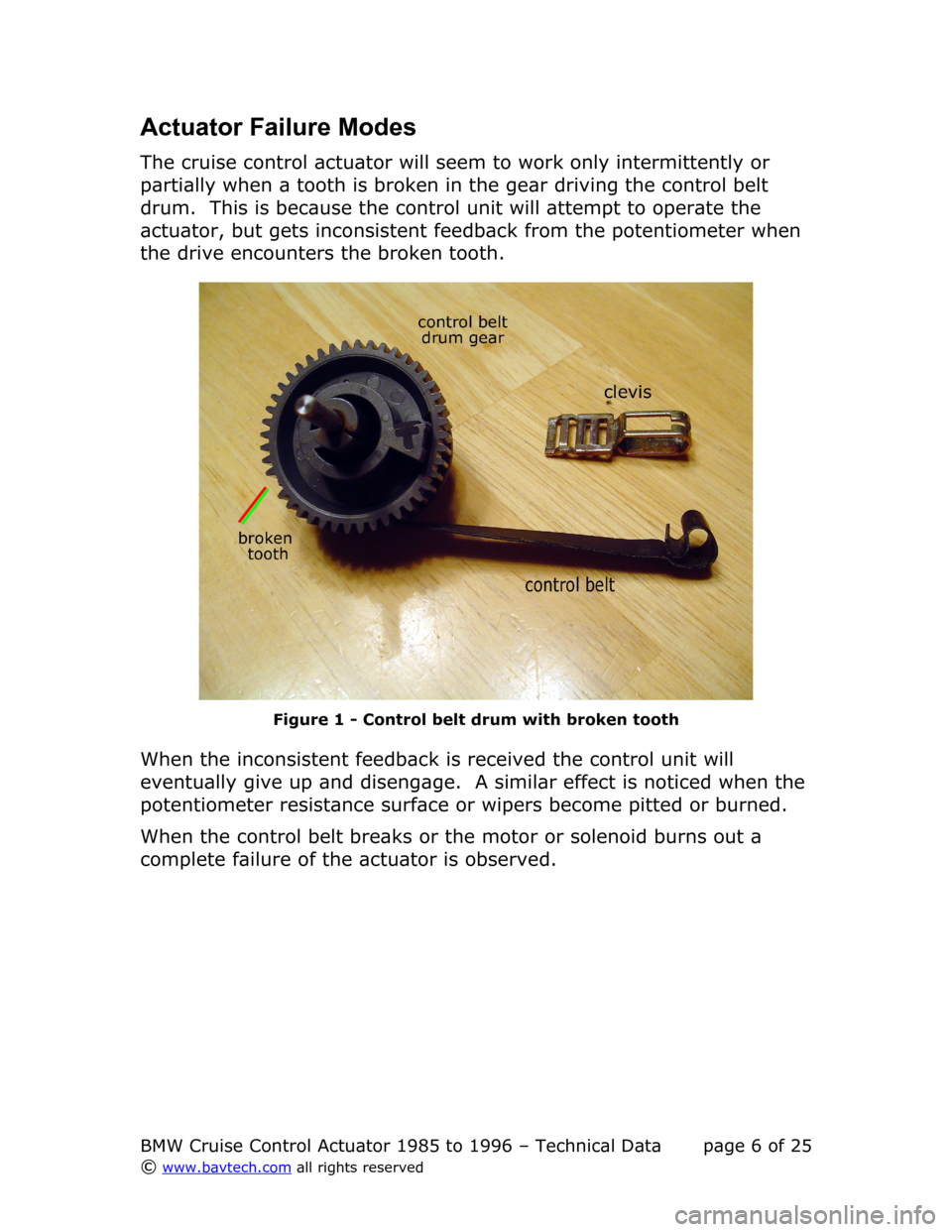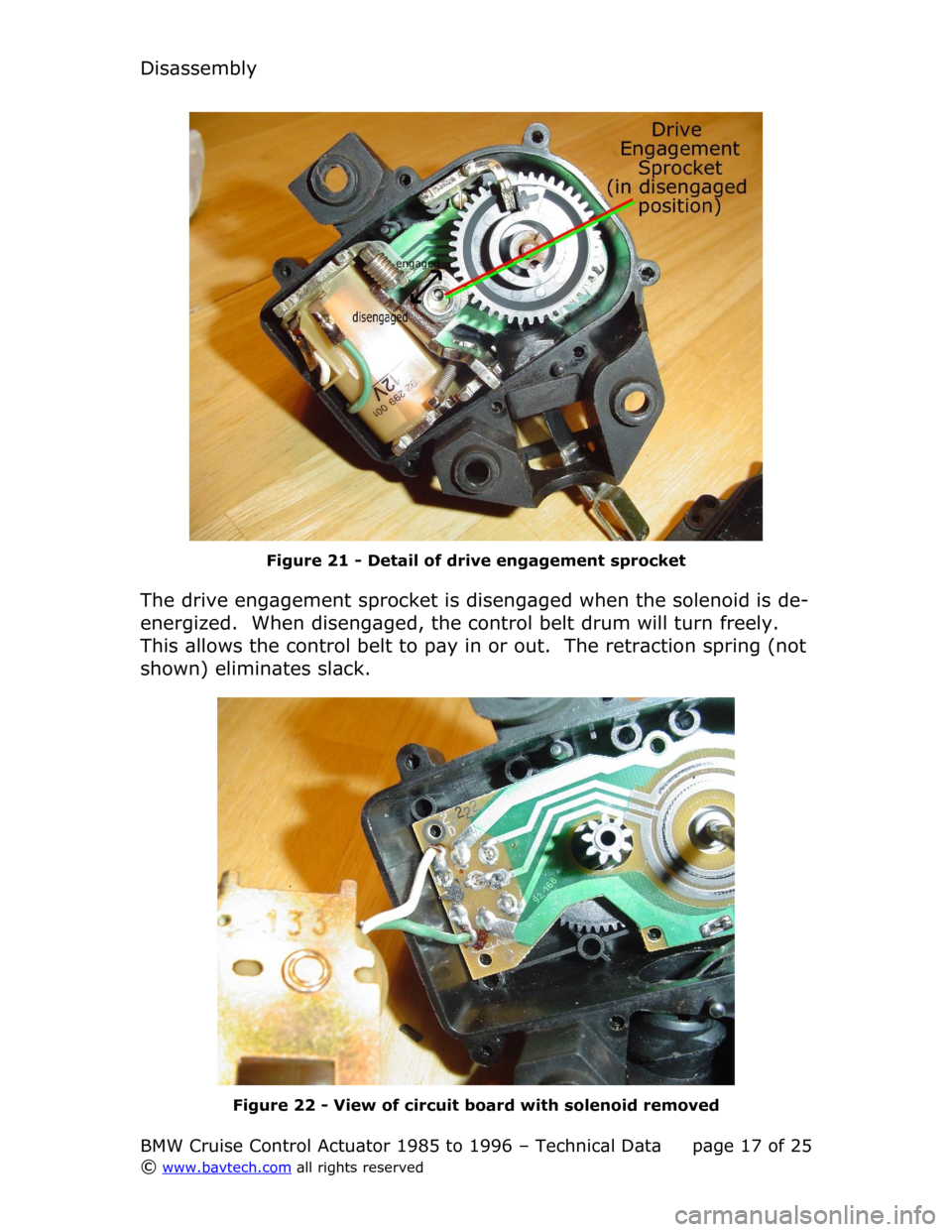belt BMW 3 SERIES 1990 E36 Cruise Control Acutator Technical Data Workshop Manual
[x] Cancel search | Manufacturer: BMW, Model Year: 1990, Model line: 3 SERIES, Model: BMW 3 SERIES 1990 E36Pages: 25, PDF Size: 3.29 MB
Page 5 of 25

Theory of Operation
The throttle is simultaneously linked by cable to the cruise control
actuator and by a second cable to the accelerator pedal. The core of
the cruise control actuator is a small motorized drum which winds or
unwinds a belt of rubberized fabric. This control belt is affixed to the
cable connected to the throttle. Thus, by winding the belt the throttle
cable can be retracted, or by unwinding it can be extended.
When the cruise control is not in use, the motor drive is disengaged
from the drum. This allows the drum to turn easily and the throttle
cable to move freely in response to accelerator pedal action. A
clockwork style spring supplies mild tension to keep the belt wrapped
around the drum and also takes up slack from the throttle cable.
A solenoid is used to engage the motor drive with the drum. When the
solenoid is energized a small armature is moved which pushes a
sprocket into contact with the integrated gear on the drum. At this
point, if current is supplied to the drive motor, the drum will wind. If
the polarity of the current is reversed, the drum will unwind.
The control unit (“brain”) is located in the electronics bay. The control
unit can thus command the actuator to engage or disengage, to reel in
the throttle cable or extend it. This provides the necessary control
capabilities.
To maintain a set vehicle speed, the control unit needs to know the
rotational position of the drum. A potentiometer (variable resistor)
integrated into the drum supplies this information to the control unit.
A resistance proportional to the position of the drum is constantly
presented to the control unit. This feedback allows the control unit to
determine how the actuator has responded to its commands.
By using the current vehicle speed (supplied by another sensor) along
with the feedback from the actuator, the control unit can adjust the
actuator as necessary to maintain vehicle speed.
BMW Cruise Control Actuator 1985 to 1996 – Technical Data page 5 of 25
© www.bavtech.com all rights reserved
Page 6 of 25

Actuator Failure Modes
The cruise control actuator will seem to work only intermittently or
partially when a tooth is broken in the gear driving the control belt
drum. This is because the control unit will attempt to operate the
actuator, but gets inconsistent feedback from the potentiometer when
the drive encounters the broken tooth.
Figure 1 - Control belt drum with broken tooth
When the inconsistent feedback is received the control unit will
eventually give up and disengage. A similar effect is noticed when the
potentiometer resistance surface or wipers become pitted or burned.
When the control belt breaks or the motor or solenoid burns out a
complete failure of the actuator is observed.
BMW Cruise Control Actuator 1985 to 1996 – Technical Data page 6 of 25
© www.bavtech.com all rights reserved
Page 15 of 25

Disassembly
Figure 17 - Control belt drum gear and retraction spring removed
Figure 18 - Detail of control belt threading through clevis
BMW Cruise Control Actuator 1985 to 1996 – Technical Data page 15 of 25
© www.bavtech.com all rights reserved
Page 17 of 25

Disassembly
Figure 21 - Detail of drive engagement sprocket
The drive engagement sprocket is disengaged when the solenoid is de-
energized. When disengaged, the control belt drum will turn freely.
This allows the control belt to pay in or out. The retraction spring (not
shown) eliminates slack.
Figure 22 - View of circuit board with solenoid removed
BMW Cruise Control Actuator 1985 to 1996 – Technical Data page 17 of 25
© www.bavtech.com all rights reserved